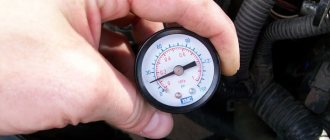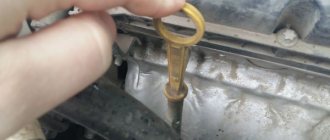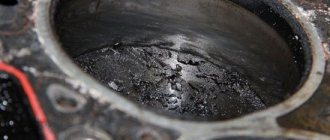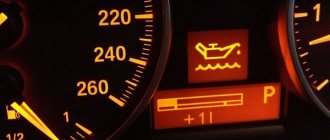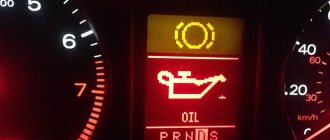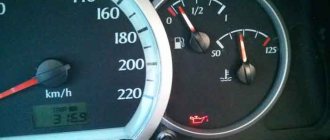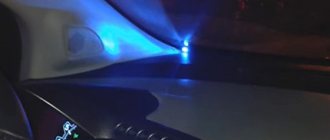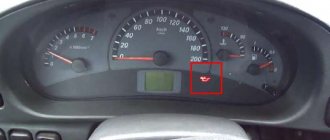The engine can function adequately only in the presence of lubricating fluid; the car owner is helped to monitor its level by a special indicator - an oil pressure lamp. This lamp may light up on the instrument panel at idle, signaling the user that it is time to check whether the amount of lubrication has decreased or another malfunction is the cause. Since the symptom indicates various problems.
Most often, malfunctions are associated with:
- filling with a lubricant product that is not suitable for current conditions in terms of operational characteristics - insufficient or excessive viscosity;
- decreased oil pump performance;
- failures in the measurements of the sensor that determines the level of pressure of the lubricating fluid;
- insufficient quality of the lubricant composition;
- problems and breakdowns of the oil pump;
- inconsistency of the selected oil with the specific type of power unit;
- a drop in lubricant level, which occurs due to leakage or increased waste consumption;
- blockage of the oil filter, channels of the vehicle’s lubrication system.
It is extremely important for the car owner to figure out what exactly caused the light to light up and blink when the engine starts.
How does the oil sensor work and why can it fail?
Let's consider the situation if you are on the road and the low pressure indicator has triggered.
The very first thing you need to do is stop the vehicle and turn off the engine. As soon as it cools down, you will have to check the lubricant level in the system. There is a special dipstick under the hood for this purpose. It is wiped dry and immersed in its original place. It is quite possible that the level will be below the minimum level. This means that somewhere there is a leak or depressurization of connections. You can set off again only after adding oil to the engine. If the lamp continues to light after starting and does not go out subsequently, it makes sense to think about towing the car to the nearest service station or to a trusted auto mechanic. The matter may turn out to be quite serious, so it is advisable to conduct the examination in a calm environment. Since we have already said that the causes of low pressure may be associated with a faulty sensor, it would be useful to understand the principle of operation of this device. There are certain contacts inside it. Until the ignition is turned on, there is no pressure in the system, so the contacts are closed. When you turn the key and turn on the ignition, but before the starter starts, the warning lamp should be on. If this does not happen, then there may be some kind of malfunction. Maybe the light bulb itself simply burned out, or maybe the contacts were broken or the sensor itself failed. As soon as we start the engine, the contacts open, leading to the light bulb going out.
Mechanism of operation
Before we look at the options for when the oil pressure light comes on at idle, let's go over the general design of engine lubrication.
Without going into technical details, it happens like this:
- The lubricating fluid accumulates and is subsequently supplied to the internal combustion engine from the storage pan. It is here that it is possible to determine its level with a dipstick.
- The pump draws lubricant into the system by rotating gears. It moves thanks to the crankshaft (as well as the camshaft and drive shaft). After being drawn in, the lubricant is cleaned by filters.
- The oil filter removes carbon deposits and prevents dirt from circulating inside, so large particles and slag settle on the cleaning mesh
- After “washing,” the oil flows through channels to all engine components. The radiator monitors the maintenance of the desired temperature (100-140 C). Valves in the lubrication system regulate the pressure required for circulation. Under the force of gravity, having gone through the entire range of procedures, the oil product settles in the crankcase, and then the process is repeated.
During normal operation, the oiler does not light up or blink, except when : sharply turning the car, cold start, pouring new lubricant. The time of such manifestations is limited to a couple of seconds (up to 20 seconds). Otherwise, read on, you're in trouble.
Why do you need an oil pressure lamp in a car?
When a car leaves the factory assembly line, it must have such an important detail as an oil pressure lamp, which informs the driver about the lack of lubrication in the engine. As soon as the “oil can” icon lights up on the instrument panel, you need to be concerned about a possible lack of oil in the engine. It is not necessary to immediately go to a car service center, first you need to identify the cause yourself, perhaps it is not so complicated and scary.
There may be several reasons for the light coming from the pressure sensor to light up:
- insufficient lubrication level in the motor;
- excess amount of lubricant in the engine;
- there is not enough pressure for the oil to work properly;
- the oil has lost its original properties and it’s time to change it.
Manufacturers expect that the sensor will work if the pressure drops to 0.4 kg/cm3 or below. In other words, as soon as you see that the “oil can” lights up, it means that your car has problems with lubrication of the rubbing parts in the power mechanism. Such failures are the most dangerous; this is fraught with the fact that the parts may jam, then the engine will be guaranteed a major overhaul or its complete replacement.
After the light comes on, you need to stop the car and find out the cause of the signal.
Dependence of oil viscosity on engine wear
As the engine wears out and the gaps increase, it is recommended to switch to cheaper types of oils. For example, switching from synthetics to semi-synthetics. The operating viscosity will decrease, which will increase the oil film in the mating parts.
It happens that after changing the oil the oil pressure light comes on. Sometimes this is due to a change in oil type, when the old one is not completely drained and it comes into conflict with the new type. Then the lubricant from a liquid state can turn into a consistency and clog the oil lines.
However, more often it happens that the new oil filter is to blame. To find out the cause of the malfunction, you need to change the filter and see if the pressure lamp goes out. If not, then you need to open the engine filler neck and, with the engine running, find out whether the oil rises to the valve cover. If not, then the problem is in the oil pump.
Reasons for the oil pressure warning light to come on
So, the warning light usually lights up after starting the engine or when it is idling. There may be several reasons for this phenomenon, but the main thing is to understand and accept for yourself that this should be a signal that there is some kind of malfunction. Therefore, you need to take appropriate measures so as not to worsen the situation. In any case, if the lamp blinks, it means that you need to identify the malfunction and do everything to eliminate it as soon as possible.
Basic reasons
The vehicle's warning lamps are controlled by the on-board monitoring system (OBS). It is designed to notify the driver of malfunctions or malfunctions of vehicle systems using these same light bulbs. In addition, the BSK is responsible for indicating turn signals, turning on high beams, rear fog lights, signaling the parking brake is applied, and so on.
The oil pressure and level light is also controlled by the on-board control system. On modern cars these are two different indicators, but on older cars there is one that lights up when the engine oil pressure in the crankcase is low.
This light bulb looks like an oil can. It lights up yellow when the oil level is below normal, and red when the pressure in the system has dropped. On some modern cars, instead of an indicator, the corresponding inscriptions are displayed on the on-board computer.
Both lights can light up independently of each other because they receive data from two different sensors.
Let's look at the reasons why the oil level/pressure lights may come on.
This is interesting: Symptoms of a malfunctioning throttle position sensor and how to check
The oil level in the crankcase is below the specified level
This problem is both the simplest and the most terrible. During operation, any engine consumes one or another amount of engine oil. Therefore, if the amount of missing fluid falls within normal conditions, then it will be enough to simply replenish the oil level.
The worst thing is when the reason for the drop in oil level is insufficient sealing of the engine or the oil leak is caused by a serious malfunction.
When the oil level is below the required level, the pressure sensor sends a signal to the electronic control unit, which notifies the BSK about the problem. Accordingly, the light on the dashboard is activated. In this case, the lamp itself does not blink, but is constantly on. This can happen both at idle and while driving, on a hot or cold engine, etc.
The oil pressure light also comes on when the ignition is turned on, but after starting the engine, if there are no problems, it goes out. In addition, it can turn on during ascent or descent, when engine oil collects in one part of the crankcase, leaving the other dry. If there are no faults, it will go out when the car is leveled.
If, after starting the engine or leveling the car after lifting/lowering, it continues to burn, you need to go to a car service center and find out the reason.
Using oil of the wrong viscosity
This problem is especially relevant in the winter season. If engine oil thickens at subzero temperatures, it is harder for the pump to pump it. Accordingly, the pressure turns out to be insufficient, which is recorded by the corresponding sensor.
Oil filter problems
There is always some amount of engine oil in the oil filter. This is necessary so that there is no oil starvation when starting the engine. Therefore, the design of the filters may include a check valve or a locking washer that retains the lubricant when the internal combustion engine is turned off.
But on low-quality filters, such components are either completely absent or do not cope with their task. Thus, the oil flows back into the oil pan. Accordingly, after startup, when the power unit gains pressure, it experiences oil starvation, which leads to increased wear. In this case, the indicator lights up for a few minutes and then disappears.
But a clogged oil filter causes much more problems. It not only creates additional stress on the oil pump, but also helps reduce pressure in the system.
Sensor malfunction
If the oil level sensor is faulty, the light will remain on constantly. Most often this happens because its slider is stuck or another breakdown has occurred, which depends on the design of the sensor. The same is true for the oil pressure sensor.
Oil pump malfunctions
Depending on what type of oil pump your vehicle has, the reasons why it fails will vary. In this case, the oil pressure light will be constantly on or flashing.
But if the oil filter mesh is clogged, then the signs are exactly the same as with a clogged filter. In addition to the fact that contamination leads to a decrease in oil level and pressure, it forces the oil pump to work harder to pump oil through the system.
Engine malfunctions
Let's talk about the most dangerous reasons. All of them are related to the condition of the engine and its specific components.
The most common reason why pressure and oil level lights come on is a leak. Most often, lubricant escapes through leaking gaskets and O-rings, pipes, oil lines, etc.
Clogged oil passages are also the cause of light bulbs. This is especially true for foreign cars where the engine oil channels are quite narrow, for example, in VAG cars. Accordingly, in such machines it is necessary to use only motor oils and high-quality fuel recommended by the manufacturer.
Wear of the cylinder-piston group of the internal combustion engine also leads to a drop in oil level and pressure. In this case, adding lubricant will help only for a short period of time, because oil consumption for waste will increase significantly. This problem can only be solved through a major overhaul of the power unit.
Antifreeze or gasoline getting into the engine oil
This usually indicates a failed cylinder head gasket. Externally, this is expressed by a constant drop in the coolant level without visible leaks, the appearance of white smoke from the exhaust pipe, the presence of a smell of fuel or coolant from engine oil, the formation of an emulsion, etc.
There are situations when the engine oil level is normal, but the oil pressure lamp is still on. In this case, the cause may be a poor-quality or clogged oil filter, a faulty oil pump, or antifreeze or gasoline getting into the lubricant.
Winter problems
Often, when starting the engine in frosts of -20 or more, the oil pressure lamp does not go out for a long time. The most common reason for this is poor quality oil. At this temperature, the lubricant thickens greatly and prevents the sensor from functioning normally. After a couple of minutes of engine operation, the lubricant becomes more liquid and the signal disappears, the sensor begins to work normally.
This is interesting: Diagnostics and repair of the ABS sensor on a car
Rare causes of oil light activation
There are a number of other unlikely reasons why the oil light on the dashboard may come on. In particular:
- Faulty wiring and/or vehicle ECU. In the first case, for example, the insulation of individual wires may be damaged, causing a false signal to be sent through the wiring to the light bulb. However, in most cases, this situation is monitored by the electronic control unit and it will automatically notify the driver about such a breakdown through the Check Engine lamp (for this you need to have an error scanner such as ELM 327). As for the ECU, this could be a banal “glitch”, that is, a computer program failure. However, this happens extremely rarely, and it makes sense to check the control unit if there are other, more complex, breakdowns. Sometimes you can find information on forums that the cause may be poor-quality soldering of one or more tracks of the control unit. Accordingly, they need to be re-soldered, but for this it is better to seek help from a car service center that has the appropriate equipment and qualified personnel.
- The oil filter was not changed during the oil change. In particular, this may cause the light to come on after an oil change. Remember that the filter must be changed when replacing the lubricant. If you have driven very little after the corresponding replacement, then you can replace this unit with a new one. If the mileage is already quite large, then it is better to change the oil again and this time together with installing an oil filter. A similar situation can occur if the new oil filter was not tightened tightly enough (the torque value must be observed, and you can find it in the technical documentation for the car) or is simply defective.
- When starting the engine in severe frosts, the oil light may light up for the first few seconds and then go out. This is due to the fact that at low temperatures the oil becomes very thick and it is difficult for the oil pump to pump it through the system; accordingly, insufficient pressure (and often vacuum) is created in it, which is perceived by the corresponding sensor as a malfunction. However, after a few seconds/minutes, the oil regains its fluidity and the pressure in the system returns to normal; accordingly, the sensor detects this, transmits a signal to the computer, and the light goes out. Please note that you should always choose oil not only in accordance with the recommendations of the car manufacturer (usually it allows the use of oils with several similar viscosities), but also with the operating conditions of the car. In particular, we are talking about low-temperature viscosity. A similar situation can occur after the car has been parked for a long time without starting the engine (for example, several months), especially if there is old (dirty) oil in the crankcase.
Gasket failure
If the gasket under the head of the block is broken, lubricant leaks and coolant gets into it. In this case, the lubricant level will be higher than normal on the dipstick; in fact, there will be coolant underneath it.
It is determined by an increased level on the dipstick, a changed color of the lubricant, and a smell coming from under the radiator cap or expansion tank. The appearance of an oil film in the tank or radiator.
Here you immediately need to replace the cylinder head gasket, cooling fluid and oil, and you can’t continue driving such a car, water getting into the engine oil is like poison for a person, it ruins him.
As you understand, a blinking pressure light can be a harbinger of serious problems, even if everything seems to be in order with the level.
Disorder with engine parts
Clogged channels of the lubrication system will also make themselves felt by a flashing pressure light. This happens because in modern engines the lubrication channels are quite narrow. To avoid clogging of the channels, you need to use only high-quality oil and good gasoline so that it does not produce precipitation, combustion waste, and these channels do not become clogged.
Low pressure may be due to severe wear of the engine CPG, then oil pours out through the increased gaps, the pressure decreases. This reason occurs in old, worn-out engines, which are long overdue for a major overhaul.
Wiring problems
Don't forget about electrical wiring. A short circuit in it can also cause the light on the dashboard to light up. Inspect externally for melted or broken wires under the hood.
How to identify and fix more complex breakdowns
To determine the reasons why the oil pressure light is on, a specialist will definitely perform the following operations:
- check oil pressure;
- diagnoses wiring faults;
- will test the condition of the sensors.
Based on the results of these operations, enough data will be obtained to determine the cause of the malfunction with a high degree of probability.
Clogged oil receiver
Oil pressure does not increase at any speed.
The breakdown can be eliminated by mechanically cleaning the oil receiver grid, for which you will have to remove the engine sump.
To do this, you need to drain the oil and unscrew all the bolts that secure the pan.
The oil receiver screen must be removed and cleaned of dirt.
Be sure to check the oil intake pipe as well.
If it is poorly screwed on or has holes, the oil pump will suck air through these leaks and the oil pressure will be low.
Video: oil intake screen clogged
Faulty oil pump or pressure relief valve
The oil pressure is low and increases slightly as the speed increases. The problem can only be resolved by replacing the oil pump.
Diagnostics of this unit is simple - you need to remove the oil pump, clamp the drive shaft into the drill chuck, lower the oil intake into a container with oil and start the drill. The oil should flow in a steady stream. Be sure to check the drill at low speeds - there is a risk of getting dirty or splashing everything around.
It is better to entrust the replacement of the oil pump to qualified auto mechanics, but if you have experience, you can do it yourself.
The engines of each car manufacturer are different, so it is advisable to carefully study the repair and operating instructions for your car before starting work.
Video: example of replacing an oil pump on an engine
With the pan removed, most engines have access to the oil pump mounting hardware.
After unscrewing all the bolts that secure the pump, carefully remove it.
We try not to damage the seals and the interface between the oil pump and the oil channels.
When installing a new pump, the main requirement is cleanliness. The presence of dirt or sand, which can lead to depressurization of the oil channels, is not allowed.
The new part should fit neatly into place, without effort or deformation.
When installing, pay attention to the alignment of the drive shaft and oil holes.
Worn crankshaft bearings
The light comes on at idle speed, and will go out as the engine speed increases.
The crankshaft will need to be diagnosed and the bearings replaced.
It is better to entrust this operation to car mechanics. They have sufficient knowledge and skills, as well as tools and access to high-tech equipment.
It is better for people without experience not to carry out work on the engine crankshaft, since the cost of a mistake is a new engine.
If you decide to check and replace the liners yourself, read the owner's manual for your vehicle. Observe all tightening torques and work order.
Diagnosis of the crankshaft is only possible if it is removed and a micrometer is available.
To remove the crankshaft, you need to unscrew the connecting rod fastenings in order from the center to the edges.
During disassembly, attention should be paid to the condition of the liners - they should be evenly worn, without scratches.
It is better to replace the inserts with new ones. In garage conditions, the crankshaft journals can only be inspected for the presence of burrs and scratches; to check the crankshaft for runout or ellipse of the journals, you need a special machine and a micrometer.
If there is wear, scuffing or scratches, the crankshaft journals are ground on a special machine, and replacement size bearings are selected.
Video: example of replacing crankshaft bearings
During installation, it is important to monitor the position of the locks.
These are special recesses that prevent the liners from turning.
The inserts must be lubricated with oil. It is necessary to monitor the correspondence of the holes in the liners and the oil channels.
After assembling the unit, it is important to tighten all bolts with the tightening torque specified in the instruction manual.
A correctly assembled crankshaft rotates by hand without excessive resistance or beating.
Oil channels clogged
If you unscrew the sensor and crank the engine with the starter, oil should come out from there.
If oil does not flow, you need to check the presence of oil, replace the oil pump with a known good one, and also blow out the oil channels with compressed air.
However, in advanced cases, clogged oil lines are almost impossible to clean.
What to do if the pressure light comes on?
The most reasonable solution in this situation would be to visit a car service center to determine why the warning light came on.
It is strictly forbidden to travel long distances if such a situation arises. This almost always indicates complex engine malfunctions that require immediate attention.
This is interesting: The starter does not turn and the solenoid relay does not click: the reason
If the light comes on while you're on the road, the easiest thing to do is check the oil level, because... This procedure does not require any special skills or additional tools.
How to do it:
- Stop the car and turn off the engine
- We wait 15-20 minutes until the engine cools down and the oil drains back into the oil pan
- Checking the oil level using a dipstick
- If the oil level is OK, then most likely there is a complex engine malfunction or a broken sensor
- If the oil level is insufficient, then, if you have a canister with lubricant, you can add fluid and drive to a car service center without loading the engine
- If there is no oil at hand, then it is best not to continue driving, but to call a tow truck or ask friends for help to get to the service station
- In the worst case scenario, you will have to continue driving under your own power, but, again, without loading the engine
Determining whether the oil pressure sensor is to blame for the light coming on is also easy. To do this, it is enough to increase the engine speed to 1000-1500 rpm at idle. If the light goes out after this action, it means the pressure is normal.
In any case, all roads lead to a car service. Even if you are able to diagnose and fix the problem on your own, it would be a good idea to consult with familiar mechanics.
Remember that if the oil pressure light comes on, you should immediately seek help from a car service center. Such breakdowns are very dangerous and even with a slight delay you can end up with major repairs or, in extreme cases, engine replacement.
Emergency situations
In winter, when driving over bumps, a situation often occurs when the car tilts and the oil gauge lamp begins to flicker. This happens in quiet driving mode, in first or second gear. Subjectively, it is felt that due to the drop in oil level on potholes, there is not enough oil for normal operation of the pump. There are no problems with the engine, it works absolutely fine. The most likely reason for this behavior is a clogged pump valve.
You can get rid of this problem as follows. You need to start the car when cold, let the engine run for about 5 seconds, then press the gas pedal 3-4 times. After this the problem goes away.
When resorting to this method, you need to be aware of the possible consequences. Strong over-throttle on a cold engine can lead to rotation of the liners, so it is better not to resort to this method on unbroken and worn engines.
Conclusion
When determining the oil pressure in the power units of a VAZ classic, there is little point in looking at the gauge needle; it is more practical to focus on the light bulb that lights up when the reading is critically low. This is enough for effective control; it is not for nothing that the manufacturer later abandoned dial gauges.
If you want to constantly monitor the oil pressure in the engine, it is better to visit a professional motor mechanic who will take measurements with a certified mechanical pressure gauge. If you want to know the oil pressure in real time, you can install a similar pressure gauge in your car and display it on the dashboard. Such pressure gauges are sold in stores; UAZ cars are equipped with them, from where they can be removed and installed on a VAZ 2101-2107.
How to check the oil pressure sensor: tips from car owners
- We need a regular tester
“I know exactly what to do if the oil can catches fire. Oil pressure is controlled by an independent sensor. Its operation can be checked with a regular tester, but to do this you need to know what resistance it should produce at a certain pressure. In general, it’s easier to change it just in case there are doubts about its functionality, having first checked the wiring, etc.” - The service will check it in five minutes
“I was driving on a dirt road and hit the ground with the guard several times, after which the light came on with a sound and a stop sign.” I went for diagnostics and checked the pan, etc. for oil leaks. The service guys said that most likely the light came on because of the sensor. Today I bought Spanish for 250 rubles. and set it down without straining. It is located a little higher and to the right of the dipstick, under some kind of plastic tube. It is better to first pull out the dipstick so that it is convenient to unscrew it with a 22 wrench. What I mean is that it’s easier to go to a service center, where they’ll check this sensor in five minutes and tell you whether you need a new one or not.” - It couldn't be simpler!
“The check is carried out as follows. 0.3 bar sensor: remove the wire from it with the car running and short it to ground - the light on the dash lights up - everything is ok. We connect everything in place. 1.8 bar sensor: remove the wire from it with the car running and do not connect it anywhere. We sit in the cabin and increase the engine speed to 2-3 thousand. If the light comes on accompanied by a sound signal, we connect everything back into place. In general, everything is very simple. If at least one of the above is not fulfilled, we look for the reason why the oil can caught fire.” - You need a multimeter and a pump with a pressure gauge
“Recently, my oil light came on. I'm not new to this and can tell you exactly what to do. To check the DDM, you need to have a pump with a pressure gauge and a multimeter. How to identify a problem in the work of DDM? First you need to connect a multimeter to test the circuit. Then connect the electrodes of the device to the sensor; the multimeter should display zero resistance.Then in this position, without disconnecting anything, you need to pump the pump, at this moment a working device should show “infinity”, since the circuit opens.”
Special malfunctions of VAZ engines
These problems are common to almost all types of engines used in cars, including domestic ones.
POPULAR WITH READERS: Do valves bend on Renault Sandero?
But there are also specific faults that occur only on certain cars.
On classic models VAZ-2106, 2107, the pump is driven from the timing chain via a drive gear and a drive roller.
A common problem in the malfunction of the lubrication system is wear of the gear sector on the gear or shaft. Replacing these elements allows you to get rid of problems.
As for modern cars, from the VAZ-2108 to the VAZ-2115, they have a direct pump drive, from the crankshaft gear.
The absence of intermediate elements in the design has increased the reliability of the drive, so the problems that arise in the engines of classic VAZs do not occur in modern cars.
How far can you travel if the indicator is on?
The answer to this question depends on why the lamp came on. If the indicator is active, then the first thing to do is check the amount of oil. If it is less than the established limit, and topping up is not possible, then you can drive the car 3–5 km at medium speeds at low speed to the place where the oil level is restored to normal.
You should not drive a car with insufficient lubricant in the engine. Otherwise, the engine will wear out faster and there will be a risk of complete breakdown. If the light starts flashing or stays on, try to fix the problem as quickly as possible.
Sources
- https://avto-kul.ru/neispravnosti-v-puti/zagorelas-kontrolnaya-lampa-davteniya-masla.html
- https://maslo.biz/interesting/zagoraetsya-lampochka-davleniya.html
- https://mirsmazok.ru/motornye-masla/gorit-lampochka-davleniya-masla-osnovnye-prichiny/
- https://fastmb.ru/autoremont/540-zagorelas-lampochka-davleniya-masla.html
- https://osensorax.ru/remont/chto-delat-esli-zagorelas-lampa-davleniya-masla
- https://topmekhanik.ru/gorit-lampochka-masla/
- https://etlib.ru/blog/948-gorit-lampochka-masla
- https://mojcar.ru/ustrojstva-avtomobilya/dvigatel/u-vas-gorit-lampochka-davleniya-masla-no-maslo-v-norme.html
- https://rad-star.ru/pressroom/articles/zagorelas-lampochka-davleniya-masla/
[collapse]
How to determine the quality of the auto chemicals used?
The quality of a lubricant is determined by its viscosity. The unit of measurement is centistokes. For each car, the manufacturer recommends its own optimal oil viscosity. For VAZ 2106, it is recommended to use oxol 0W or 5W in winter, and 20W and 30W in summer. If suspicion arises and inspection is not possible, the lubricant should be replaced.
This procedure is carried out as follows:
- 10 minutes after the engine has been turned off, you need to unscrew the plug and completely drain the lubricant.
- Screw the cap back on and fill in the appropriate product.
- Start the engine and let it run at minimum speed for 2 minutes.
- Stop the engine and wait 5 minutes.
- Check the lubricant level and top up if necessary.
How do you know which oil is suitable? First, follow the manufacturer's recommendations. And secondly, trust only well-known, well-established brands.
If the oil receiver is clogged, then it is not difficult to guess why the lubricant pressure drops. There simply won’t be enough of it supplied to the pump. If the valve breaks, the situation is different. Here, on the contrary, an increased bypass of oxol will be observed. The reason must be sought by the method of sequential elimination. First, check whether the strainer is in normal condition. If clogged, it is washed in gasoline and replaced. A valve malfunction in a VAZ 2106 car most often occurs due to a failure of the spring, which has to be replaced with a new one.
